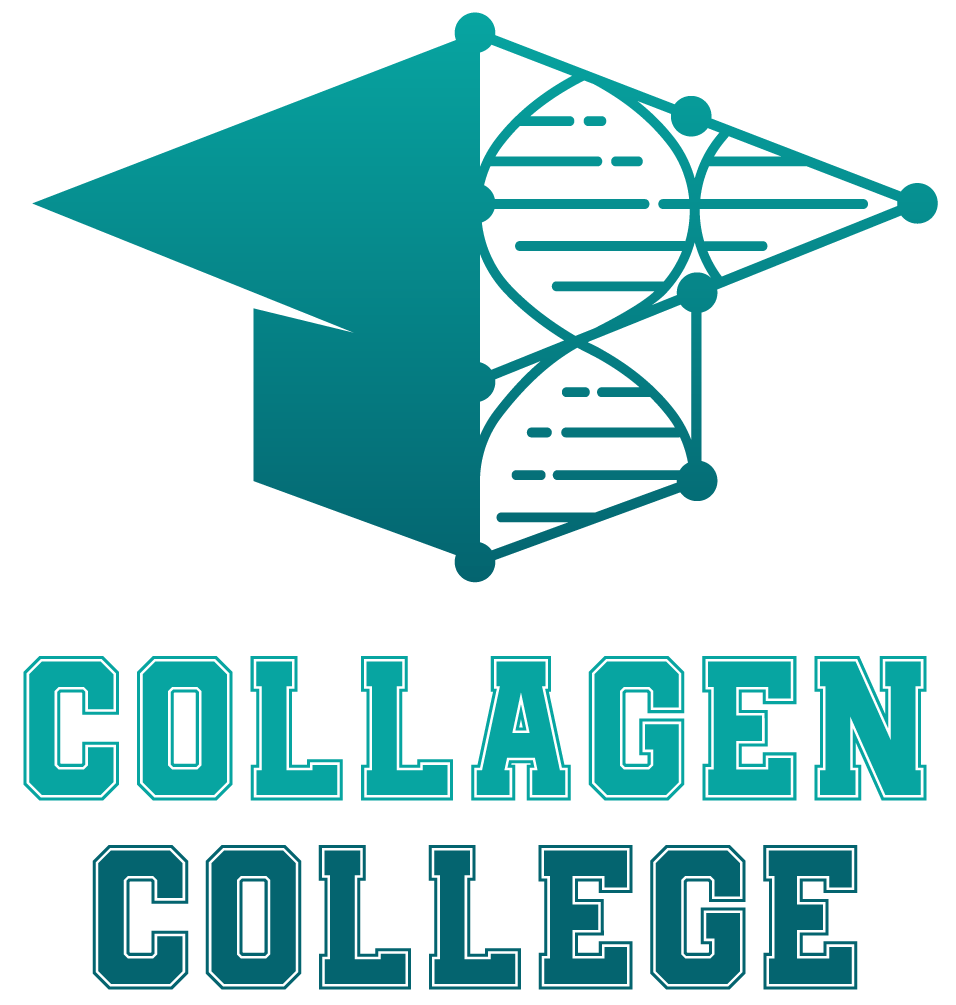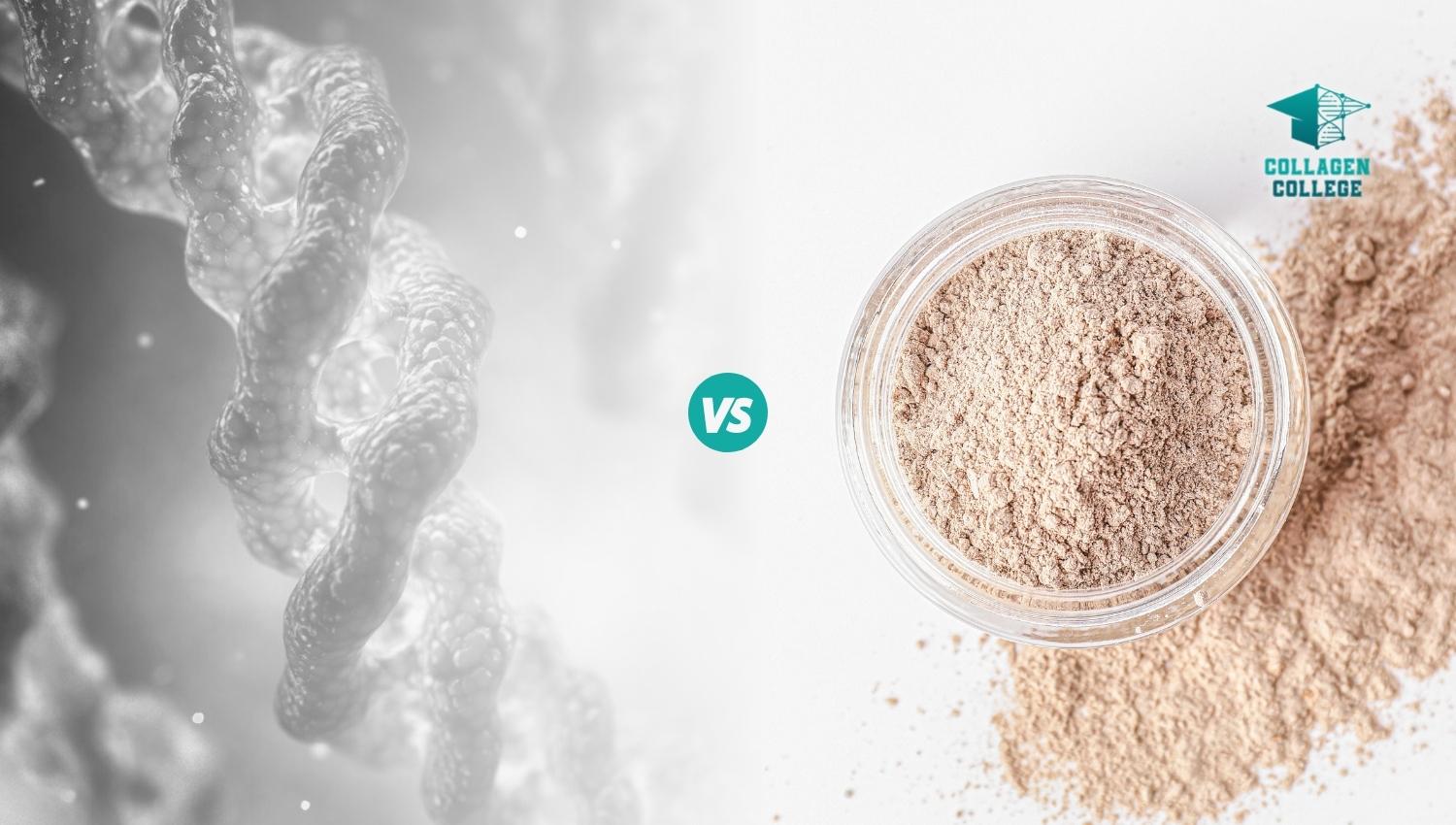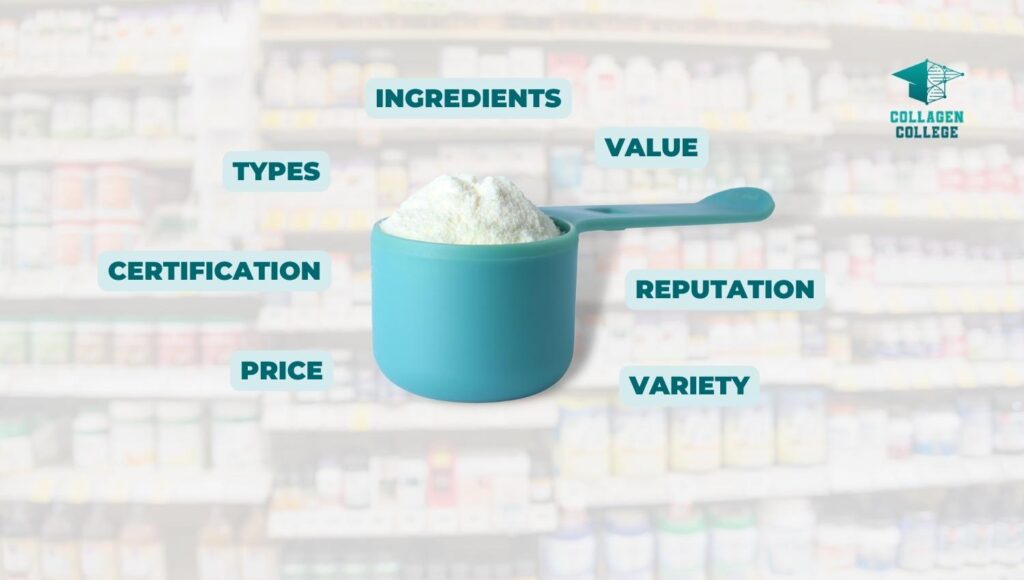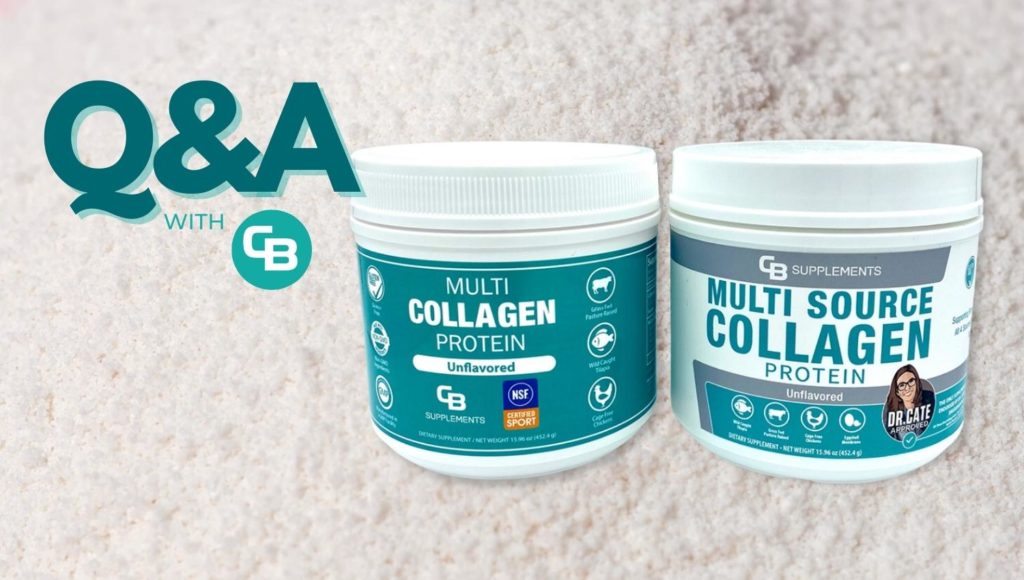That’s right, Dr. Cate.
Puddles. Just like Sponge Bob.
Collagen is the current superstar of supplements and the awesome nutrient found in a few select foods that most of us don’t eat anymore (which is a shame).
Whether you’re seeking to understand the makeup of collagen from a supplement perspective, or the natural food way, this article is for you. We’ll unequivocally answer the fundamental question, “Is collagen protein?”, and expound our answer to additionally discuss whether collagen is a good source of protein, the supplement side (peptides), what to expect in grams per serving, and more.
Let’s start with the basics of understanding protein.
Protein 101
Proteins are large, complex molecules essential to all living cells’ structure and function. They are made up of long chains of smaller molecules called amino acids, which are linked together in a specific sequence. When you think of protein, think amino acids. There are 20 different types of amino acids that can be combined in various ways to create different proteins.
Protein is vital for maintaining the health and functions of all living organisms, from bacteria to plants to animals.
Protein’s role in the human body
Let’s focus on a single living organism, which is us. Humans. Hooray us.
- Structural support
- Enzymes
- Transport
- Hormones
- Immune function
- Energy
Types of Protein
Let’s zoom out a bit and highlight the three common types of protein sources. Understanding these sources will help paint the broader picture of understanding if collagen is protein, so let’s explore them quickly.
3 years of benefits!
"Been using this multi collagen for 3 years and continue to experience positive benefits!"
- Michael (Winter Park, FL)
✔
Purity Tested
✔
M.D. Approved
✔
Delicious Flavors
1. Animal-based proteins
These include meats, poultry, fish, eggs, and dairy products like milk, cheese, and yogurt. Animal proteins are generally considered the most complete protein sources, as they contain all of the essential amino acids in the right proportions.
2. Plant-based proteins
While most plant proteins are not complete on their own, combining different plant-based protein sources can create a complete protein. For example, beans and rice or hummus and pita bread are complete protein sources when eaten together. Other plant-based protein sources include tofu, tempeh, nuts, seeds, soy, and legumes like lentils and chickpeas.
3. Protein supplements

Protein supplements like whey protein, casein protein, and (spoiler alert!) collagen protein can be a convenient way to increase protein intake. However, it’s important to choose a high-quality protein supplement that is free from fillers and additives. Look for products manufactured in GMP facilities and boast third-party certification, such as NSF — like our NSF certified collagen line of products.
Now that we have a good understanding of protein and its sources, let’s (finally) address the million-dollar question!
Is Collagen a Protein?
Yes! Remember above when I mentioned protein is amino acids?
Collagen is a protein because it’s made up of amino acids, and amino acids are the building blocks of protein. Furthermore, collagen is the most abundant type of protein found in the human body, approximately one-third of the body’s protein content. It is a fibrous protein that forms the structural framework of our connective tissue, such as skin, bones, cartilage, and tendons.

Does collagen count as protein?
Collagen is in and throughout our bodies — along with all mammals — but if you eat it via foods and/or supplements, does it count towards your overall protein intake like other animal and plant-based proteins?
Of course! Collagen is a fibrous structural protein. The chemistry behind collagen is just like other proteins — long chains of amino acids. Let’s inspect those amino acids.
Collagen Protein = Amino Acids
Collagen’s amino acid profile is made up of 19 total amino acids, heavily concentrated in Glycine, Proline, and Hydroxyproline (“Big 3”). These 3 amino acids are the magic behind collagen’s rejuvenating healing. They are also the backbone of collagen’s unique strong and durable triple-helix structure.
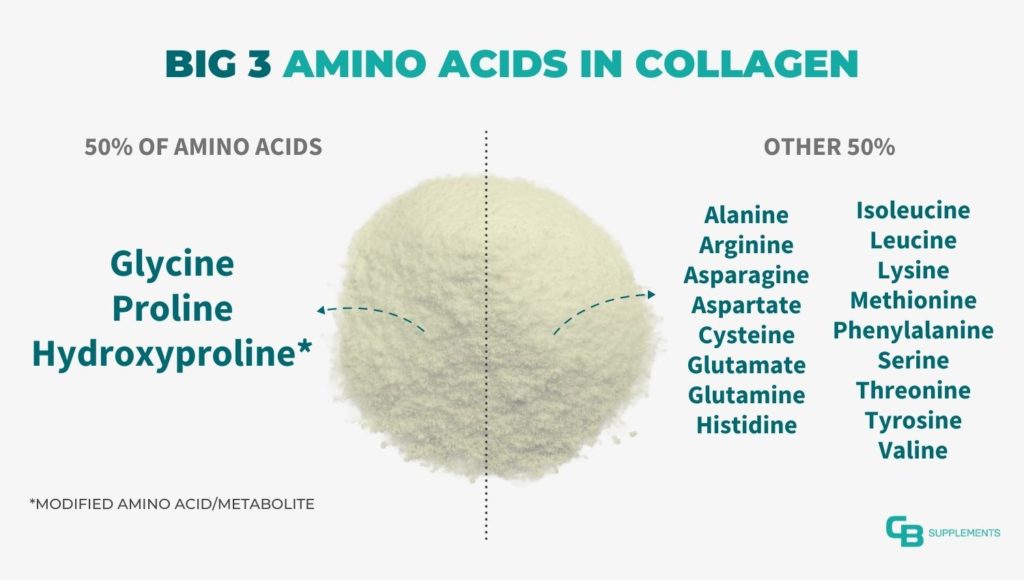
When I shared the types of protein above, you’ll probably remember we touched on complete proteins.
The knock against collagen (for those unfamiliar with collagen’s uniqueness) is that collagen is not a complete protein — it’s missing the amino acid tryptophan. Does that mean collagen isn’t a protein? Absolutely not. Collagen is a protein, it’s just not complete. Should that worry you in this conversation about collagen and protein? Again, absolutely not!
Hey Dr. Cate, why is collagen so special?
Collagen has special properties found nowhere else in the edible world.
— Dr. Cate, M.D.
This fact is so incredibly important.
Does collagen have protein?
This question, “Does collagen have protein?”, is probably a foregone conclusion if you’ve been following along. However, I believe we can deepen our understanding of collagen here.
Yes, collagen has protein, whether you consume it naturally via certain collagen-rich foods (bone broth, certain organ meats, etc.) or through supplements (aka hydrolyzed peptides). When you eat collagen, from either method, you simply are eating amino acids.

When most people think of “collagen”, they think of just supplements. I challenge you to broaden your view and remember that collagen has/is protein, and collagen protein can be found in both foods (albeit few) and supplements!
Speaking of supplements, let’s answer this question again, but from a supplement perspective.
Are collagen peptides protein?
Do collagen peptides have protein?
Collagen peptides (aka hydrolyzed collagen) are an excellent way to add collagen protein to your diet. Peptides, are derived from collagen protein and are a more broken-down form of collagen thanks to hydrolysis. That allows collagen peptides to be packaged up and conveniently offered in various forms of collagen supplements, such as powders, pills, gummies, etc.

Collagen supplements can pack a punch with grams of collagen protein per serving. Many collagen powders, such as our multi collagen supplements, pack at least 7g of collagen protein per serving (more on that in a minute).
For the record, if this nomenclature of collagen/collagen peptides/hydrolyzed collagen confuses you — we do apologize on behalf of the entire collagen supplement world. Collagen peptides are the same as hydrolyzed collagen, learn more:
How much Protein is in Collagen?
Now that we know collagen is protein, collagen has protein, and you can get collagen protein from food and/or supplements, let’s talk about how much protein is in collagen.
The answer depends on your choice of consumption: collagen-rich foods or collagen supplements. Supplements will have a more concentrated dose of collagen protein per serving. On the other hand, foods that contain collagen protein will typically have less collagen protein per serving but offer more satiation and other nutrients.
To get your 10-40 grams of collagen every day, there’s a strong case that should do both. But, let’s beef up this recommendation and break this down further.
How much collagen protein in food?
Knowing how much collagen protein is in whole foods is quite the conundrum for 3 main reasons:
- Limited options. There are only a few foods that contain collagen protein.
- No labels. Whole foods, since they don’t contain additional ingredients, have no nutrition labels.
- It depends. The amount of collagen can vary depending on the type of food (e.g. tripe vs eggs) and preparation method (e.g. homemade bone broth vs store bought.)
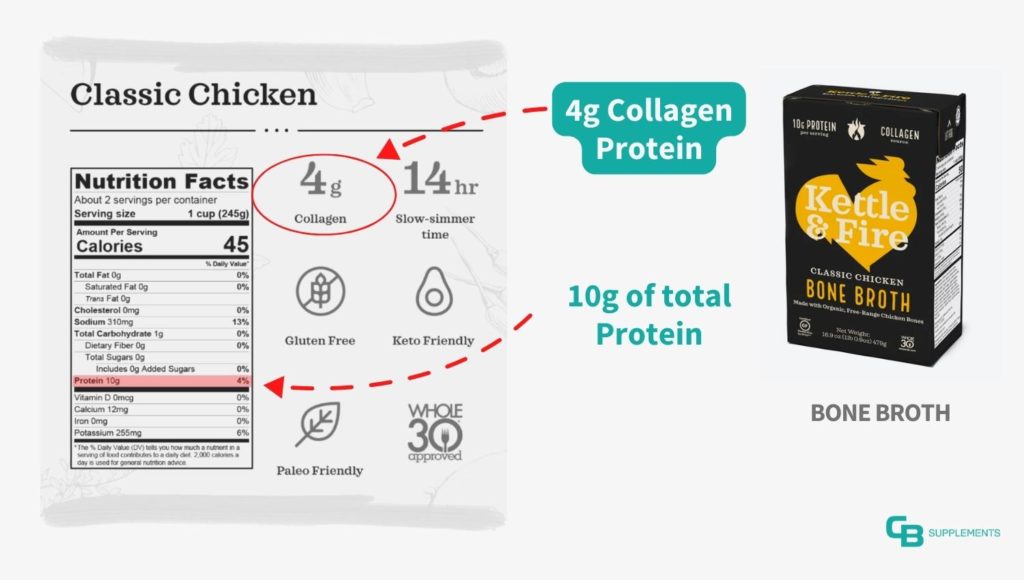
Here are some examples of how much collagen protein is in food:
- 1 cup of Bone Broth = 4g. Probably the only food at a grocery store where you’ll find the exact amount specified on the label.
- 1 cup of cooked Beef Tripe = 6g. A great way to eat collagen, if you have the palette to eat a cow’s second stomach. :/
- 1 Egg = 0.1g. Probably the least effective way to get collagen since collagen sits in the eggshell membrane.
- 12 Chicken Wings = 0.25g. Though full of collagenous parts (skin, tendons, etc.), only a small fraction of the total protein is collagen.
- 3 oz. Ribeye Steak = 1-2g. You can expect about 3% of a steak to contain collagen.
Though we always encourage folks to eat real food before supplementing, you’ll see below why collagen supplementation is a more potent, convenient, and easier way to get collagen protein in your diet.
How much collagen protein in supplements?
Since the FDA requires all supplements to place a Supplemental Facts label on their packaging, this becomes a lot easier than estimating collagen protein via foods. However, there are challenges here too.
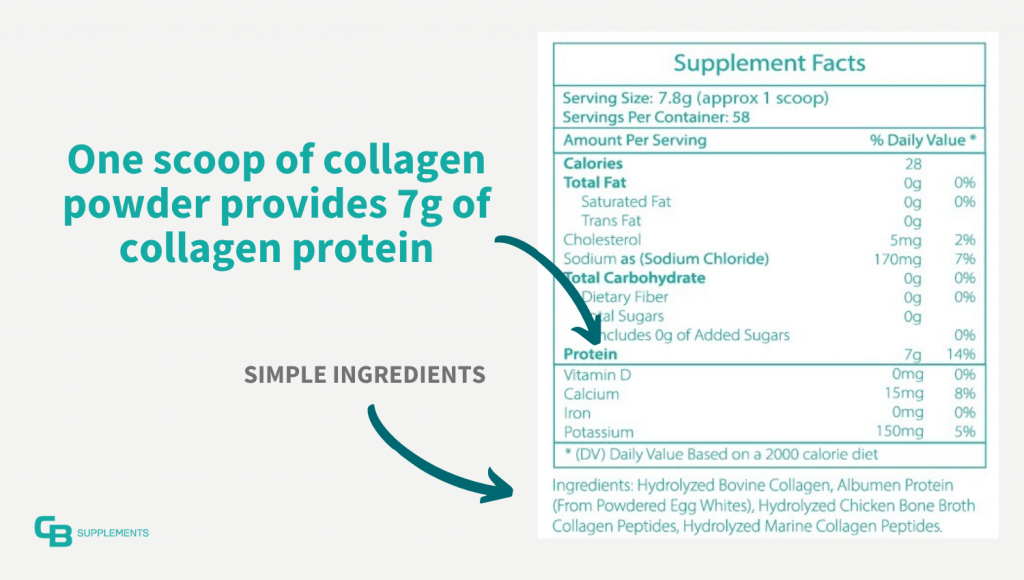
The amount of collagen protein in supplements will vary based upon:
- Type of supplement. Powder, pill, gummy, liquid, etc. (see our collagen powder vs pills comparison guide)
- Serving size.
- Quality of supplement. Label says 10g of collagen protein, but is it really 10g? Supplement companies, unfortunately, can use wildly inaccurate labels.
With that said, if you’re buying a quality supplement that has third-party certification and purity testing (we have both btw), this is just about reading labels. Charlie says it best:
Since collagen is protein, the amount of grams of protein in collagen is 100%; meaning, a serving size of 7g of collagen will equal 7g of protein.
— Charlie Bailes
Founder
If 150 pounds shoot for 20+ grams of collagen protein daily, which is 3 scoops of our multi collagen powder. Since there are at least 17 ways to take collagen powder, this is an absolute breeze to plan, consume, and track your collagen protein intake!

Is Collagen a Good Source of Protein?
Collagen, in foods and supplements, is not only a good source of protein but a critical one that your whole body needs — especially as we age.
Though collagen is not a complete protein nor aids in muscle protein synthesis (like other proteins, such as whey), its unique amino acid profile creates a bioactive peptide and vitally important to our connective tissue, tendons, ligaments, joints, bones, gut, circulatory health, and hair/skin/nails. And though collagen’s superpower is not muscle growth, you need strong joints to have strong muscles!
When we consume collagen, via collagen-rich foods and/or supplements, scientific evidence shows it increases our collagen production through the stimulation of fibroblast cells. And when those awesome fibroblast cells are stimulated, they create more collagen! The more collagen your body has, the better — reason why we recommend “banking” your collagen at any age.
For more ways your body uses and relies on collagen, don’t miss our 7 benefits of collagen protein powder.
Should I only take collagen protein?
Since we’ve touted the awesome benefits of collagen protein, you might be thinking:
Do I need other types of protein? Can I only take collagen?
— You, maybe?
No, it is not recommended to rely solely on collagen protein as your primary source of protein. Though collagen has benefits for your entire body (connective tissue, digestive health, skin/hair/nails, etc.), it’s not a complete protein — as we explored above. Since collagen protein is missing the amino acid tryptophan, we’d recommend getting a well-rounded intake of protein by adding in meats, poultry, fish, eggs, dairy products, nuts, and seeds to your collagen consumption.
We know this is tricky since there’s no RDA for collagen. But again, if you’re shooting for 10-40 grams per day, and you know your total protein goal, you can mix and match proteins to ensure you’re giving your body everything it needs.
Final Takeaway
Collagen is, unequivocally, a protein. Without collagen, we’d all be puddles.
Once you understand collagen’s uniqueness, compared to other proteins, you can begin planning how to consume collagen by eating foods that contain collagen protein or supplementing. For many people, doing both is a convenient and cost-effective way to get your daily collagen intake.
